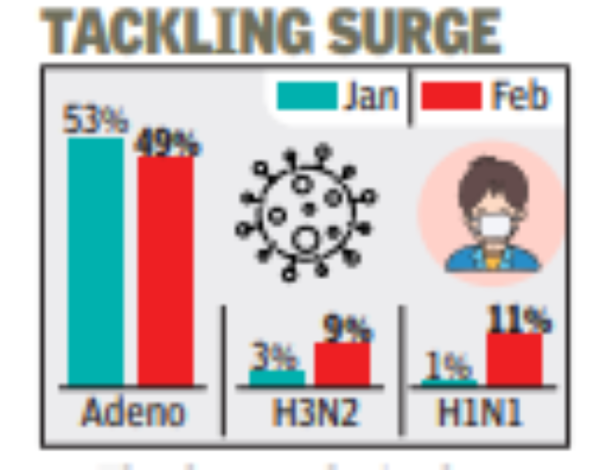Top Searches
- News
- City News
- kolkata News
- Drop in adeno, rise in H3N2 & H1N1 in West Bengal
Drop in adeno, rise in H3N2 & H1N1 in West Bengal

Representative image
KOLKATA: Bengal health department officials, assessing infection data, have noticed a surge in influenza caused by H3N2 and H1N1 (swine flu), even as they confirmed a slight dip in the number of adenovirus infections, compared with January and February.
The rising trend in H3N2 and H1N1 cases has been described as "alarming".

The officials, quoting data about circulating viruses, said 54% of all viral infections were due to adenovirus in January. This came down to 49% by the end of February. Correspondingly, while only about 1% of all viral infections in January was due to H1N1, it is now 11% of all respiratory infections.
Till January, only 3% of all viral infections was due to H3N2; it now contributes to about 9% of all viral infections.
The data analysis, they said, was being carried out to take combat and containment measures in time.
"Based on lab reports, we noticed an increasing number of H3N2 and H1N1 cases," said a senior health official. "While adenovirus infections were mainly a cause of concern in the paediatric population, the other two viruses can affect individuals across all age groups, especially the elderly with co-morbidities. We are setting up measures to combat the surge on a war footing," he added.
There were only 12 H3N2 cases reported in the state in January. From February to now, there have been 58 more cases.
From January till date, 83 cases of H1N1 have been reported, including 19 cases from Kolkata. TOI, on March 13, had reported the rising trend of H3N2 cases. According to that report, labs were detecting anything between 40% and 70% H3N2 cases in all Influenza A-positive samples.
In 2022, Bengal reported 659 H1N1 cases, but with the most cases were reported in August (421) and September (132). There were no cases detected in January and February. “The early appearance of H3N2 and H1N1 is cause for concern,” said a health official.
“The numbers are likely to rise in the next few weeks. We all need to take precaution- .”Bengal reported 216 confirmed adenovirus cases in January. The number rose to 311 in February.
Sources said the rise in cases in February was also due to increased testing, adding that adenovirus identification in March was showing a gradual declining trend.As a preparedness measure, the government has identified 11 government labs and the one at ICMR-NICED — five of those in Kolkata — to detect HINI and H3N2. Fifteen more private labs have been asked to remain prepared to face a surge.
The rising trend in H3N2 and H1N1 cases has been described as "alarming".

The officials, quoting data about circulating viruses, said 54% of all viral infections were due to adenovirus in January. This came down to 49% by the end of February. Correspondingly, while only about 1% of all viral infections in January was due to H1N1, it is now 11% of all respiratory infections.
Till January, only 3% of all viral infections was due to H3N2; it now contributes to about 9% of all viral infections.
The data analysis, they said, was being carried out to take combat and containment measures in time.
"Based on lab reports, we noticed an increasing number of H3N2 and H1N1 cases," said a senior health official. "While adenovirus infections were mainly a cause of concern in the paediatric population, the other two viruses can affect individuals across all age groups, especially the elderly with co-morbidities. We are setting up measures to combat the surge on a war footing," he added.
There were only 12 H3N2 cases reported in the state in January. From February to now, there have been 58 more cases.
From January till date, 83 cases of H1N1 have been reported, including 19 cases from Kolkata. TOI, on March 13, had reported the rising trend of H3N2 cases. According to that report, labs were detecting anything between 40% and 70% H3N2 cases in all Influenza A-positive samples.
In 2022, Bengal reported 659 H1N1 cases, but with the most cases were reported in August (421) and September (132). There were no cases detected in January and February. “The early appearance of H3N2 and H1N1 is cause for concern,” said a health official.
“The numbers are likely to rise in the next few weeks. We all need to take precaution- .”Bengal reported 216 confirmed adenovirus cases in January. The number rose to 311 in February.
Sources said the rise in cases in February was also due to increased testing, adding that adenovirus identification in March was showing a gradual declining trend.As a preparedness measure, the government has identified 11 government labs and the one at ICMR-NICED — five of those in Kolkata — to detect HINI and H3N2. Fifteen more private labs have been asked to remain prepared to face a surge.
Start a Conversation
FOLLOW US ON SOCIAL MEDIA
FacebookTwitterInstagramKOO APPYOUTUBE









